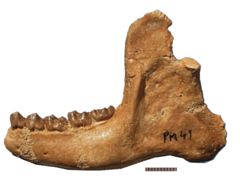Project 1153: E. Gheerbrant, M. Amaghzaz, B. Bouya, F. Goussard, C. Letenneur. 2014. Ocepeia (Middle Paleocene of Morocco): The Oldest Skull of an Afrotherian Mammal. PLOS ONE.
Abstract
While key early(iest) fossils were recently discovered for several crown afrotherian mammal orders, basal afrotherians, e.g., early Cenozoic species that comprise sister taxa to Paenungulata, Afroinsectiphilia or Afrotheria, are nearly unknown, especially in Africa. Possible stem condylarth-like relatives of the Paenungulata (hyraxes, sea-cows, elephants) include only Abdounodus hamdii and Ocepeia daouiensis from the Selandian of Ouled Abdoun Basin, Morocco, both previously only documented by lower teeth. Here, we describe new fossils of Ocepeia, including O.grandis n. sp., and a sub-complete skull of O. daouiensis, the first known before the Eocene for African placentals. O.daouiensis skull displays a remarkable mosaic of autapomophic, ungulate-like and generalized eutherian-like characters. Autapomorphies include striking anthropoid-like characters of the rostrum and dentition. Besides having a basically eutherian-like skull construction, Ocepeia daouiensis is characterized by ungulate-like, and especially paenungulate-like characters of skull and dentition (e.g., selenodonty). However, some plesiomorphies such as absence of hypocone exclude Ocepeia from crown Paenungulata. Such a combination of plesiomorphic and derived characters best fits with a stem position of Ocepeia relative to Paenungulata. In our cladistic analyses Ocepeia is included in Afrotheria, but its shared derived characters with paenungulates are not optimized as exclusive synapomorphies. Rather, within Afrotheria Ocepeia is reconstructed as more closely related to insectivore-like afroinsectiphilians (i.e., aardvarks, sengis, tenrecs, and golden moles) than to paenungulates. This results from conflict with undetected convergences of Paenungulata and Perissodactyla in our cladistic analysis, such as the shared bilophodonty. The selenodont pattern best supports the stem paenungulate position of Ocepeia; that, however, needs further support. The remarkable character mosaic of Ocepeia makes it the first known “transitional fossil” between insectivore-like and ungulate-like afrotherians. In addition, the autapomorphic family Ocepeiidae supports the old – earliest Tertiary or Cretaceous – endemic evolution of placentals in Africa, in contrast to hypotheses rooting afrotherians in Paleogene Laurasian “condylarths”.Read the article »
Article DOI: 10.1371/journal.pone.0089739
Project DOI: 10.7934/P1153, http://dx.doi.org/10.7934/P1153
| This project contains |
|---|
Download Project SDD File |
Currently Viewing:
MorphoBank Project 1153
MorphoBank Project 1153
- Creation Date:
04 March 2014 - Publication Date:
25 July 2014 - Project views: 23928

- Media downloads: 1

Authors' Institutions ![]()
- Muséum national d'Histoire naturelle, Paris (Natural History Museum, Paris)
- Office Chérifien des Phosphates (OCP SA), Morocco
Members
| member name | taxa |
specimens |
media |
| MorphoBank Curator Project Administrator | 1 | 1 | 1 |
| Maureen Admin Full membership | 0 | 0 | 0 |
| Emmanuel Gheerbrant Full membership | 0 | 0 | 0 |
Project has no matrices defined.
Project views 
| type | number of views | Individual items viewed (where applicable) |
| Total project views | 23928 | |
| Project overview | 4444 | |
| Media views | 6844 | Media search (6009 views); M326761 (835 views); |
| Documents list | 2459 | |
| Bibliography | 1347 | |
| Specimen list | 3251 | |
| Taxon list | 2515 | |
| Views for media list | 3068 |
Project downloads 
| type | number of downloads | Individual items downloaded (where applicable) |
| Total downloads from project | 398 | |
| Project downloads | 388 | |
| Document downloads | 9 | Ocepeia Matrix (7 downloads); Character List (2 downloads); |
| Media downloads | 1 | M326761 (1 download); |

